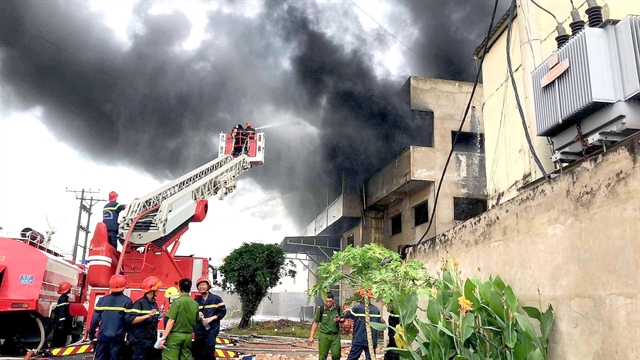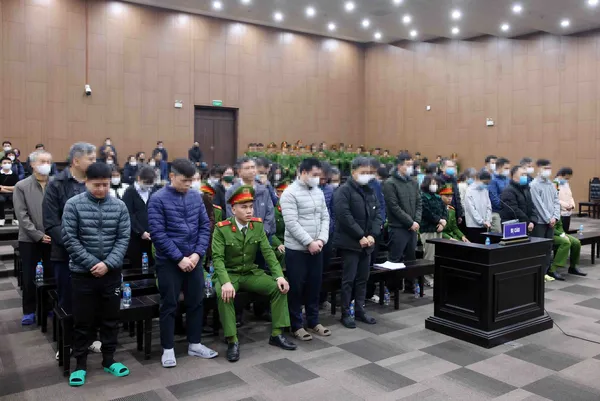 Society
Society

The National Assembly spent the whole day yesterday discussing the implementation of policies and laws on fire prevention and fighting from 2014-2018.

|
| Firefighters battle a blaze at a cushion storage facility in HCM City's Bình Tân District in late October this year. VNA/VNS Photo |
HÀ NỘI — The National Assembly spent the whole day yesterday discussing the implementation of policies and laws on fire prevention and fighting from 2014-2018.
During that time, failure to raise the alarm promptly was the main reason for huge fires that caused devastating losses.
At the sitting, Chairman of the NA’s Committee of National Defence and Security Võ Trọng Việt presented a report regarding supervision of the issue.
Việt stressed that huge fires were an emerging issue that needed to be focused on.
Between July 2014 and July 2018, only giant blazes were reported, accounting for 0.96 per cent of the total number of cases, but causing devastating consequences.
In those incidents, 35 people were killed and 72 others were injured. They caused estimated damage of more than VNĐ4.9 trillion (US$211 million), accounting for 76.2 per cent of the total.
Việt said most big huge fires were caused by slow reactions of people and authorised agencies. Fires were detected but the alarm was raised late, allowing them to spread which made tackling them all the more challenging.
Notably, up to 80 per cent of blazes were reported to the fire service at least ten minutes after they broke out. Sometimes it took 30 minutes before agencies were informed.
Việt cited the fire at Tuấn Thông Trading and Commerce Co,Ltd in HCM City, which produced plastic items, as an example. Firefighters were only informed about the two blazes 42 and 48 minutes after they broke out.
Thousands of square metres of factories were burnt down due to the delay, causing billions of đồng in losses.
Việt said the total number of fires during the period reviewed was high - more than 13,140, killing 346 people and leaving 823 injured.
Fires mostly broke out in urban areas and densely populated areas, accounting for 60 per cent. Of that, 42 per cent were reportedly house fires.
Despite the complicated nature of fires, the implementation of firefighting policies had been neglected and impractical, he said.
Many fire drills did not look at the reality of residential areas in HCM City and Hà Nội located down deep alleys with high population densities, which caused difficulties for firefighters.
Urban water supplies in Hà Nội, Hải Phòng and Khánh Hoà Province did not meet the requirements, while natural water sources from ponds, lakes, rivers and canals used for firefighting had been exhausted due to the rapidly increasing rate of construction.
The report also revealed the network of firefighting and rescue teams failed to meet the requirements.
There was only one firefighting and rescue team for areas covering hundreds of kilometres.
On average, each officer was in charge of managing 150 establishments in six districts, and between five to 10 residential areas while the stipulated number was no more than 100 establishments.
The number of vehicles equipped for firefighting was substandard as nearly 30 per cent of trucks had been in use for more than 20 years, and 23.5 per cent were in poor condition.
In addition, special firefighting vehicles for blazes involving gasoline and chemicals at large-scale industrial zones or underground projects were still lacking.
Deputy Đoàn Thị Thanh Mai from Hưng Yên Province said the firefighting organisation in urban areas needed due attention.
Mai said deep alleys and traffic congestion had blocked fire trucks from accessing many blazes. The city was facing a shortage of 7,000 hydrants, 300 reservoirs and 400 natural sources.
Thus, it was urgent to revise and build a qualified infrastructure system for the work.
Mai suggested that construction projects should only be put into use after fire prevention measures had been checked and accepted, and they should be periodically checked. Fire drills would also be held to improve people's ability to respond to fires, especially in high-rise apartment buildings.
Deputy Leo Thị Lịch from Bắc Giang Province raised concern over the restricted design of firefighting vehicles.
Ladders on fire trucks could reach the 20th floor, while encroachment on residential areas, commercial centres and big markets were common, blocking the ways for trucks to reach blazes.
Lịch said local police and officers should be trained to react quickly to fires. Local authorities needed to strengthen inspections of private businesses, especially karaoke bars, to ensure the implementation of regulations on fire prevention and fighting.
Those found violating the regulations must be closed down, she said.
Deputy Cao Thị Xuân from Thanh Hoá Province reminded the NA of a recent forest fire which was caused by human carelessness.
Seven hectares of forest in Hương Sơn District was razed when a farmer tried to burn wild grass. The farmer was sentenced to two years in jail.
Another farmer in Nghi Sơn District was put behind bars for setting light to a protection forest while trying to burn leaves in his garden.
Xuân said education was needed to protect the forests.
To improve effectiveness, the NA supervision delegation asked the Government to continue building policies on firefighting and rescue.
Local authorities, in co-operation with the Ministry of Public Security, needed to build criteria on fire prevention and fighting and a plan to stop construction works that failed to meet the fire regulations.
This would require the ministry to classify high-risk areas and prepare measures to react promptly in the case of fire. — VNS




